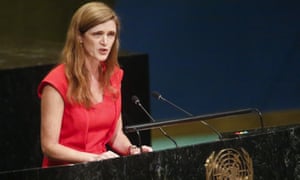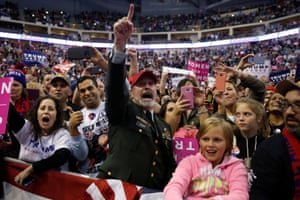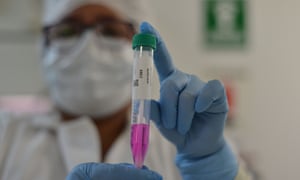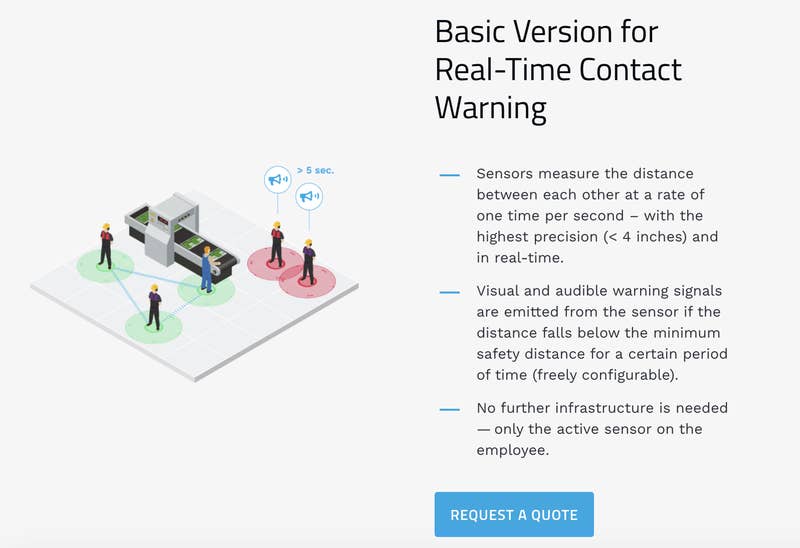'Gross incompetence at highest levels': ex-Obama adviser blasts Trump's Covid response
Samantha Power also tells online Hay festival that former US administration underestimated how ‘ripped off’ Americans felt, and discounts possibility of Michelle Obama as vice-president

The US has shown “gross incompetence … at the highest levels” in dealing with the Covid-19 pandemic, according to Samantha Power, who served as US ambassador to the United Nations under Barack Obama.
Speaking to Philippe Sands for the online version of the Hay festival, Power said that Donald Trump’s administration had failed to learn from the countries hit by the coronavirus before the US.
“We could have had an awful lot in place before it struck in earnest on the continent,” she said, highlighting the “gross incompetence” shown “not by the heroic health workers and public servants who are on the frontlines, but at the highest levels, diminishing the threat posed by the pandemic in its early stages”.
Power served for four years as Obama’s human rights adviser and from 2013 to 2017 in his cabinet and as US ambassador to the UN. The coronavirus outbreak in the US has been “mishandled for a set of reasons that go well beyond the pandemic, a scepticism about science and evidence and global cooperation,” she said.

She admitted that the Obama administration had “definitely underestimated the potency” of “a view represented by President Trump but shared by millions of Americans, that the international system has ripped us off, that we have been giving more than we’ve been getting”.
“We saw the pain caused, of course, by economic globalisation and saw the degree to which many in our own communities were being left behind. But the idea that that would be laid squarely on political globalisation or on alliances or on the United Nations, it was not accurate, it seemed like too big a leap to get the fuel and the momentum that Trump has given it, so we were wrong to underestimate that,” she said.
Power was asked by Sands if there was any coming back for the US after what he called “almost irrecoverable” damage done to the support for global order by the Trump presidency. Power said it wasn’t just about Trump threatening to pull out of the World Health Organization, and withdrawing the US from organisations including Unesco and the United Nations human rights council.
“There is that. But maybe even more damaging than that is the pullback from alliances that are at the heart of effective multilateralism … How do you recover the belief among German, French, British, Irish, Spanish citizens that when America attaches its name to an agreement, whether a climate agreement, or an Iran nuclear agreement, that is going to be an enduring signature?” she said. “What Trump has jeopardised more than anything is the sense of American constancy, [that] we’re going to be there when you need us. And that’s going to be the hardest thing of all, I think to build back that trust.”

Power was hopeful that Joe Biden will emerge the victor at this November’s presidential election due to Trump’s handling of the pandemic.
“You can holler fake news and be kind of tribal in terms of your party mentality. But if your insulin prices have tripled, and you no longer have a paycheck and the government subsidy you’re getting isn’t enough to pay for insulin for your kid, there’s only so many Trump tweets and allegations of voter fraud that are going to distract you from your own plight,” said Power, who recently published her memoir, The Education of an Idealist.
Asked by Sands if there was any chance that Michelle Obama would step in as Biden’s vice-president, Power said that while there was a “very, very, very slim” possibility because of “how much she cares about the country”, it was unlikely.
“I suppose there is some scenario where maybe she could be convinced that this is the only way,” Power added. “But now that Biden has at least a modest lead in some of the polls, I think she’ll be convinced probably that there are other paths. I’m not sure anybody who has seen the presidency up close would volunteer for it.”












